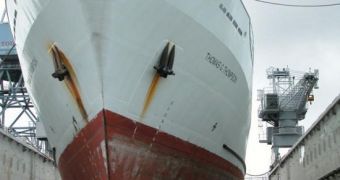People can now watch the endeavors of a scientific expedition making its way across the planet's oceans from the comfort of their own homes, via a dedicated website.
The Enlighten '10 research effort is being conducted by experts at the University of Washington, which are traveling hundreds of miles from their state's coasts into the Pacific Ocean.
The goal of the travels is to reach destinations where the team can conduct high-depth robotic explorations of the areas, using Autonomous Underwater Vehicles (UAV).
The machines can reach as far as one mile under the surface of the water, OurAmazingPlanet reports.
Using Google Earth, people at home can keep an eye on the location of the Navy vessel Thomas G. Thompson, which the UW team uses to get around.
This is a research vessel that features 22 crew members and 36 scientists, and which has a length of 84 meters. It is especially well suited for conducting this exact type of marine investigations.
One of the main targets for investigation is sulfide chimneys, structures that develop near hydrothermal vents.
These are some of the most extreme places on Earth, seeing how, in addition to the massive oceanic pressure at their location, they are also releasing large amounts of dangerous gases.
The vents provide a way for tension accumulated in the planet's mantle to be released. The mantle is the viscous layer of molten rock on which Earth's crust – landmasses and oceanic plates – float.
Some 480 kilometers off the coast of Oregon, scientists discovered the Axial Volcano, which is home to the hydrothermal vent El Guapo.
The UW team conducted a series of drills on the structure, which is located 1,410 meters (nearly a mile) under the surface of the ocean.
They now that the chimney is teeming with life on the outside, but the robots they manipulated drilled a series of holes that are meant to house a series of instruments for analyzing life within.
The researchers are very curious to learn how organisms survived within the sulfide chimney. In addition, the recent digs are only the first stage of a more massive project, which aims to wire the entire oceanic floor in the region.
“By 2014, the 800-kilometer network of fiber-optic and electrical cables and instruments will allow scientists, educators, students and the public to observe and interact with the oceans via the internet in entirely new ways, 24/7, for decades,” says UW in Seattle expert John Delaney, the chief scientist for the cruise.
You can track the expedition via here.

 14 DAY TRIAL //
14 DAY TRIAL //